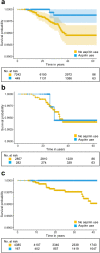The association between acetylsalicylic acid and subarachnoid haemorrhage: the Framingham Heart Study
- PMID: 37085588
- PMCID: PMC10121705
- DOI: 10.1038/s41598-023-33570-9
The association between acetylsalicylic acid and subarachnoid haemorrhage: the Framingham Heart Study
Abstract
Studies investigating the association between acetylsalicylic acid (ASA) use and spontaneous subarachnoid haemorrhage (SAH) in the general population have produced conflicting results. The aim of this study is to clarify the relationship between SAH and ASA. We included all participants who reported on ASA use during interim examinations of the Framingham Heart Study Cohorts. Using Cox proportional-hazards regression modelling, we estimated the hazard ratio (HR) associated with ASA use. 7692 participants were included in this study. There were 30 cases of SAH during follow up, with an estimated incidence of 10.0 per 100,000 person- years (CI 6.90-14.15). Univariate analysis showed no association between regular ASA use and SAH (HR, 0.33 [0.08-1.41]; p = 0.14). This was similar when accounting for smoking (HR, 0.35 [0.08-1.51]; p = 0.16). Using a large longitudinal dataset from the Framingham Heart Study, we observed some evidence suggesting fewer SAH in those participants taking regular ASA. However, multivariate statistical analysis showed no significant association between ASA use and SAH. Due to the low incidence of SAH in the general population, the absolute number of SAH events was low and it remains uncertain if a significant effect would become apparent with more follow up.
© 2023. The Author(s).
Conflict of interest statement
The authors declare no competing interests.
Figures
Similar articles
-
Aspirin and Subarachnoid Haemorrhage in the UK Biobank.Transl Stroke Res. 2023 Aug;14(4):490-498. doi: 10.1007/s12975-022-01060-1. Epub 2022 Jul 9. Transl Stroke Res. 2023. PMID: 35809217
-
Antithrombotic drugs and subarachnoid haemorrhage risk. A nationwide case-control study in Denmark.Thromb Haemost. 2015 Nov;114(5):1064-75. doi: 10.1160/TH15-04-0316. Epub 2015 Jul 23. Thromb Haemost. 2015. PMID: 26202836
-
Sex, Smoking, and Risk for Subarachnoid Hemorrhage.Stroke. 2016 Aug;47(8):1975-81. doi: 10.1161/STROKEAHA.116.012957. Stroke. 2016. PMID: 27444257
-
Worldwide Incidence of Aneurysmal Subarachnoid Hemorrhage According to Region, Time Period, Blood Pressure, and Smoking Prevalence in the Population: A Systematic Review and Meta-analysis.JAMA Neurol. 2019 May 1;76(5):588-597. doi: 10.1001/jamaneurol.2019.0006. JAMA Neurol. 2019. PMID: 30659573 Free PMC article.
-
Sex-Specific Associations of Smoking with Spontaneous Subarachnoid Hemorrhage: Findings from Observational Studies.J Stroke Cerebrovasc Dis. 2020 Oct;29(10):105144. doi: 10.1016/j.jstrokecerebrovasdis.2020.105144. Epub 2020 Aug 4. J Stroke Cerebrovasc Dis. 2020. PMID: 32912496
References
Publication types
MeSH terms
Substances
Grants and funding
LinkOut - more resources
Full Text Sources


